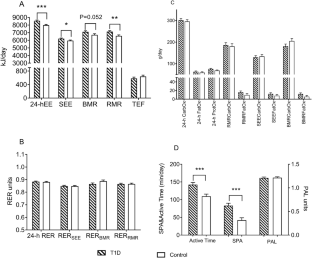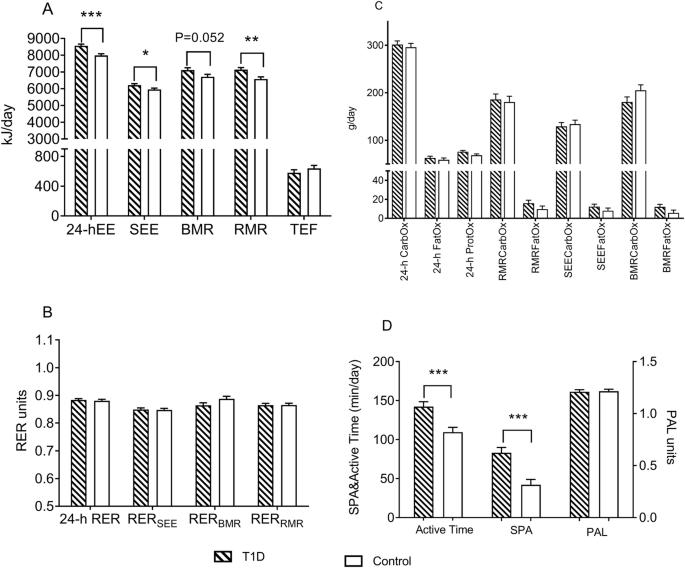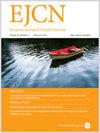1 型糖尿病患者的 24 小时能量消耗:对临床能量消耗估算公式的影响。
IF 3.6
3区 医学
Q2 NUTRITION & DIETETICS
引用次数: 0
摘要
背景/目的:1 型糖尿病(T1D)与静息代谢率(RMR)的增加有关,但 T1D 对 24 小时能量消耗(24-h EE)的其他组成部分的影响尚不清楚。此外,还缺乏估算 T1D 患者 24 小时能量消耗的方程。本分析的目的是比较不同体重指数(BMI)的 T1D 青壮年患者和健康对照组的 24 小时能量消耗及其组成部分,并从临床变量中推导出 T1D 特异性方程:本次分析纳入了 33 名确诊 T1D ≥1 年的年轻成人和 33 名性别、年龄和体重指数匹配的健康对照者。我们在全室间接热量计(WRIC)中测量了24小时EE,并用双X射线吸收测定法测量了身体成分:结果:T1D 患者的 24 小时 EE 明显高于健康对照组(T1D= 2047 ± 23 千卡/天 vs 对照组= 1908 ± 23 千卡/天;两者的 P 2 = 0.912)。未纳入自发体力活动的临床模型也产生了较高的决定系数(身体成分模型和人体测量模型的决定系数分别为 R2 = 0.897 和 R2 = 0.880):这些结果证实,与未患 T1D 的对照组相比,已确诊 T1D 的年轻成人的 24 小时 EE 增加了。根据临床可用变量推导出的方程可帮助临床医生为 T1D 患者开出体重管理的能量处方。本文章由计算机程序翻译,如有差异,请以英文原文为准。


24-h energy expenditure in people with type 1 diabetes: impact on equations for clinical estimation of energy expenditure
Type 1 diabetes (T1D) is associated with an increase in resting metabolic rate (RMR), but the impact of T1D on other components of 24-h energy expenditure (24-h EE) is not known. Also, there is a lack of equations to estimate 24-h EE in patients with T1D. The aims of this analysis were to compare 24-h EE and its components in young adults with T1D and healthy controls across the spectrum of body mass index (BMI) and derive T1D-specific equations from clinical variables. Thirty-three young adults with T1D diagnosed ≥1 year prior and 33 healthy controls matched for sex, age and BMI were included in this analysis. We measured 24-h EE inside a whole room indirect calorimeter (WRIC) and body composition with dual x-ray absorptiometry. Participants with T1D had significantly higher 24-h EE than healthy controls (T1D = 2047 ± 23 kcal/day vs control= 1908 ± 23 kcal/day; P < 0.01). We derived equations to estimate 24-h EE with both body composition (fat free mass + fat mass) and anthropometric (weight + height) models, which provided high coefficients of determination (R2 = 0.912 for both). A clinical model that did not incorporate spontaneous physical activity yielded high coefficients of determination as well (R2 = 0.897 and R2 = 0.880 for body composition and anthropometric models, respectively). These results confirm that young adults with established T1D have increased 24-h EE relative to controls without T1D. The derived equations from clinically available variables can assist clinicians with energy prescriptions for weight management in patients with T1D.
求助全文
通过发布文献求助,成功后即可免费获取论文全文。
去求助
来源期刊
CiteScore
10.60
自引率
2.10%
发文量
189
审稿时长
3-6 weeks
期刊介绍:
The European Journal of Clinical Nutrition (EJCN) is an international, peer-reviewed journal covering all aspects of human and clinical nutrition. The journal welcomes original research, reviews, case reports and brief communications based on clinical, metabolic and epidemiological studies that describe methodologies, mechanisms, associations and benefits of nutritional interventions for clinical disease and health promotion.
Topics of interest include but are not limited to:
Nutrition and Health (including climate and ecological aspects)
Metabolism & Metabolomics
Genomics and personalized strategies in nutrition
Nutrition during the early life cycle
Health issues and nutrition in the elderly
Phenotyping in clinical nutrition
Nutrition in acute and chronic diseases
The double burden of ''malnutrition'': Under-nutrition and Obesity
Prevention of Non Communicable Diseases (NCD)

 求助内容:
求助内容: 应助结果提醒方式:
应助结果提醒方式:


